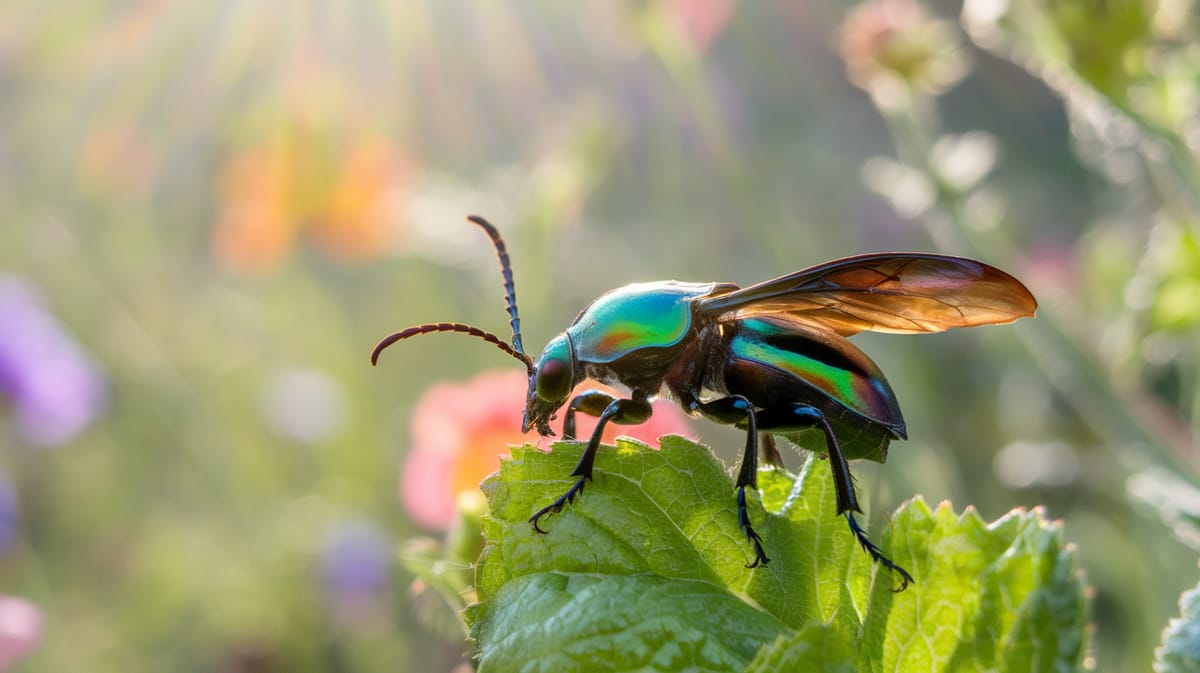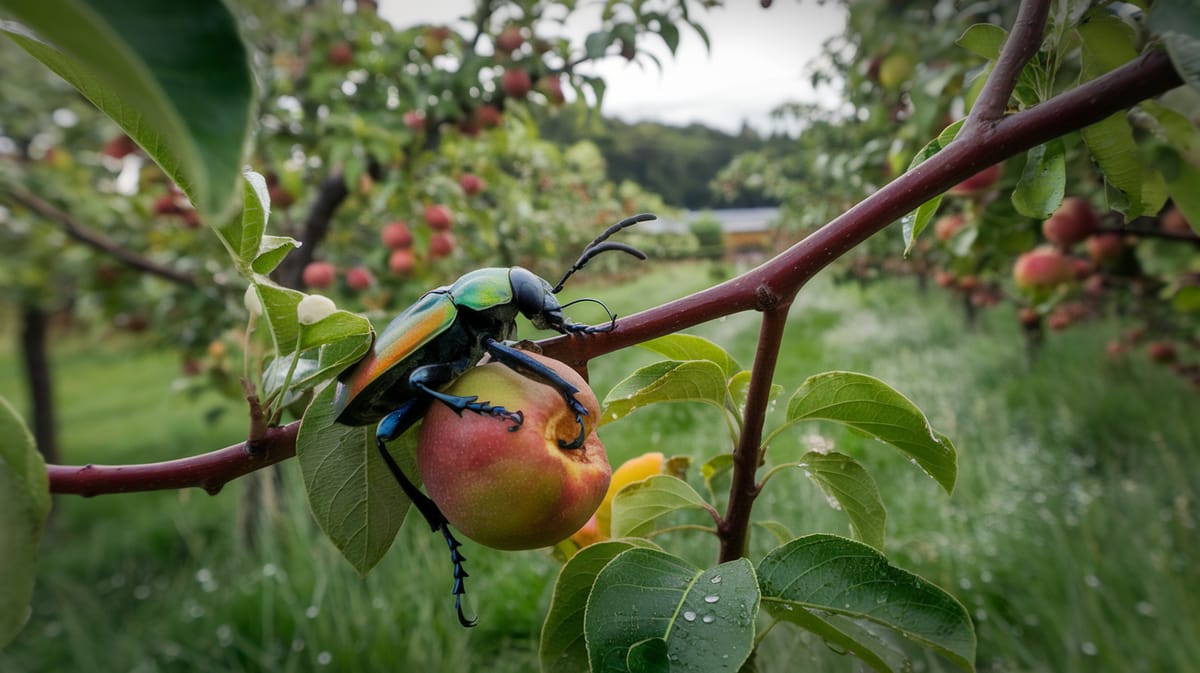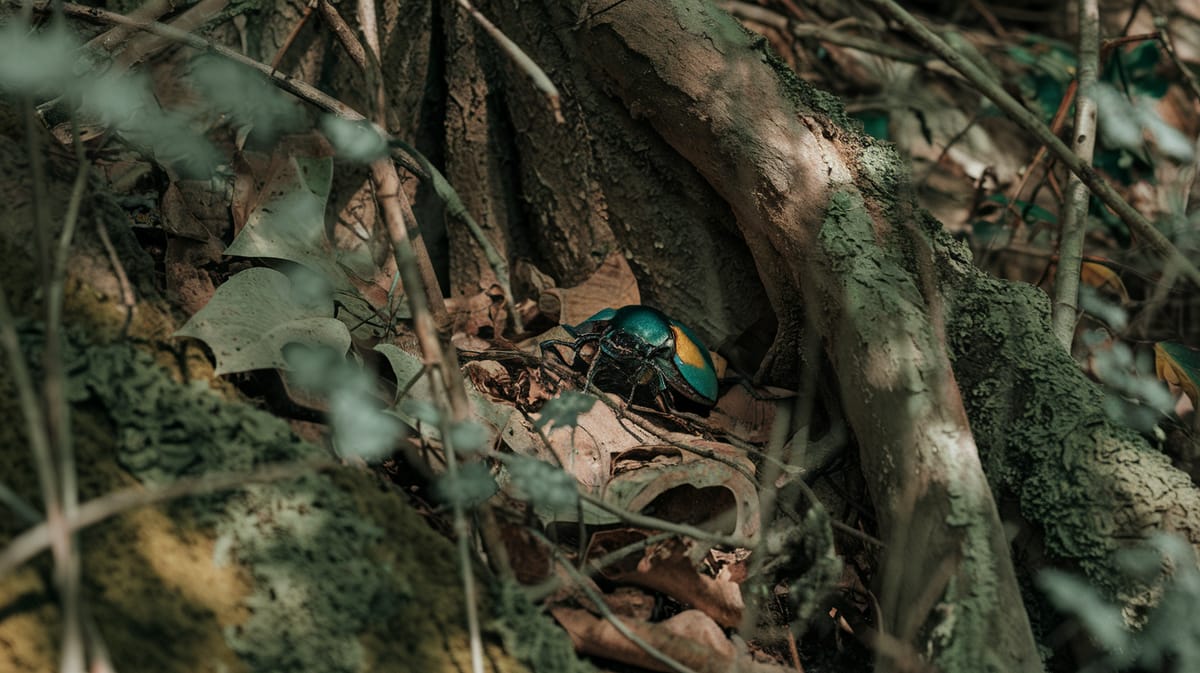Japanese Beetle
Gleaming in metallic green and bronze, the Japanese Beetle is a voracious leaf-muncher notorious for its impact on gardens. Despite its destructive nature, it plays a role in soil aeration.

Key Insights at a Glance
Did You Know?
Taxonomy & Classification
Japanese Beetles are vibrant herbivores known for their metallic green and bronze hues, intricately linked to their evolutionary adaptation to diverse environments. Let's understand the evolutionary journey and classification of these remarkable herbivores.
Global Presence
Japanese Beetles, native to Japan, have spread across North America, thriving in diverse climates.
Evolutionary Resilience
Originating over 30 million years ago, these beetles have adapted to survive various environmental changes.
Lifecycle and Growth
A remarkable journey of transformation from Egg to Adult.
Egg
Laid in moist soil, eggs develop into larvae, relying on environmental moisture for successful hatching.
Larva
Feeding on roots, larvae grow through three instars, playing a crucial role in soil aeration.
Pupa
Transitioning in underground cells, pupae form protective shells while developing adult features.
Adult
Emerging from soil, adults engage in feeding on foliage and mating, crucial for reproduction.
Dietary Habits
A voracious feeder with a broad palate, this insect targets a wide range of plant species, causing significant foliage damage.
| DIET TYPE | DESCRIPTION |
|---|---|
| Primary Diet | Feeds primarily on leaves of roses, grapevines, and fruit trees, leaving skeletonized remains behind. |
| Secondary Diet | Also consumes flowers and ripened fruits, contributing to its reputation as a destructive garden pest. |
| Occasional | Occasionally feeds on turfgrass roots in larval stage, affecting lawns and pastures under certain conditions. |

Behaviour and Adaptations
Discover the fascinating traits that make the Japanese Beetle a unique survivor in its environment.
Feeding Efficiency
Consumes over 300 plant species, impacting agriculture and ecosystems significantly.
Mating Swarms
Large groups gather to mate, ensuring high reproduction rates.
Grub Survival
Larvae thrive underground, feeding on roots for sustenance.
Ecosystem Impact
Understanding how Japanese Beetles influence ecological dynamics.
Soil Aeration
Their burrowing larvae help aerate soil, promoting nutrient cycling.
Food Source
Serves as prey for birds and mammals, supporting biodiversity.
Pollination Assistance
Adult beetles occasionally pollinate flowers while feeding.
Conservation Challenges
Understanding and addressing the major threats to Japanese Beetle populations.
Chemical Exposure
Pesticides disrupt beetle ecosystems and reduce their survival rates.
Habitat Loss
Urban development and agriculture decrease beetle habitats.
Climate Change
Altered weather patterns impact beetle reproduction and food availability.
Frequently Asked Questions
How long do Japanese Beetle live?
Japanese Beetles typically live for about 30 to 45 days. They emerge as adults in early summer and are most active during warm, sunny days. Their short lifespan includes mating, feeding, and laying eggs before their lifecycle ends.
What do Japanese Beetle eat?
Japanese Beetles feed on over 300 plant species. They prefer leaves, flowers, and fruits of plants like roses, grapes, and beans. They skeletonize foliage, leaving only the veins, and can cause significant damage in large numbers.
Are Japanese Beetle poisonous?
Japanese Beetles are not poisonous to humans or pets. They do not secrete toxins or cause allergic reactions. They can be a nuisance due to their feeding habits, but they pose no direct health threat.
Are Japanese Beetle endangered?
Japanese Beetles are not endangered. They are considered invasive pests in North America, where they have established large populations. Their adaptability and lack of natural predators in these areas contribute to their abundance.
What do Japanese Beetle symbolize?
In some cultures, beetles symbolize transformation, renewal, and the cycle of life. However, Japanese Beetles are mainly recognized as pests due to their destructive impact on agriculture and gardens rather than any symbolic meaning.
Do Japanese Beetle bite?
Japanese Beetles do not bite humans. They possess chewing mouthparts for feeding on plants, but they do not have any interest in biting people or animals. Their primary focus is on consuming plant material.
What color are Japanese Beetle?
Japanese Beetles are metallic green with copper-brown wing covers. This striking coloration makes them easily recognizable. Their undersides are a shiny green, and they have small white tufts of hair along their sides.
Does a Japanese Beetle have wings?
Yes, Japanese Beetles have wings. They possess a pair of hard forewings called elytra, which protect the delicate hind wings used for flying. They are capable fliers and often move between plants in search of food.
What does a Japanese Beetle look like?
Japanese Beetles are about 0.5 inches long, with a metallic green body and coppery brown wing covers. They have six legs, a small head, and distinct white tufts of hair along their sides. Their appearance makes them easy to identify.
Is a Japanese Beetle an insect?
Yes, a Japanese Beetle is an insect. It belongs to the family Scarabaeidae, commonly known as scarab beetles. Like all insects, they have a three-part body structure: head, thorax, and abdomen, as well as six legs and two antennae.
Related Insects
Discover insects with similar characteristics to Japanese Beetle - including shared habitats, diets, and taxonomic classifications
Share this profile
Help others discover Japanese Beetle
